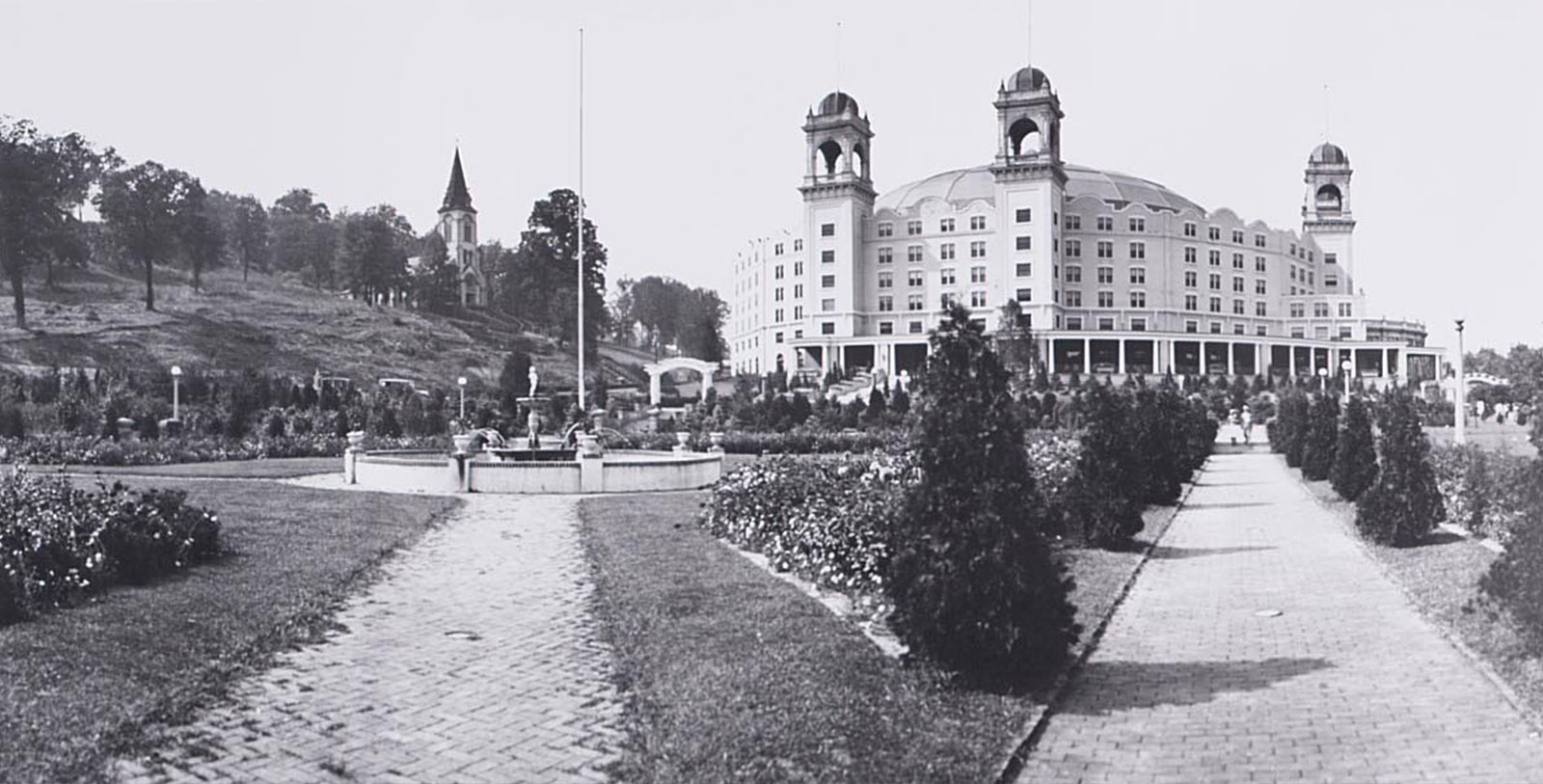Receive for Free - Discover & Explore eNewsletter monthly with advance notice of special offers, packages, and insider savings from 10% - 30% off Best Available Rates at selected hotels.
history
In the first three decades of the 1900s, West Baden Springs Hotel served as a famed vacation spot for socialites, political figures and captains of industry.
The hotel, sister to French Lick Springs Hotel, in French Lick, Indiana, West Baden Springs Hotel was known as the “Eighth Wonder of the World” and THE place to visit in the Western States. Its dome, which at the time, held the title of the world’s largest, served as the focal point for the structure and the interior was designed with the grandest spas of Europe in mind.
The lands of French Lick Springs served as an idyllic hunting ground for the Native Americans for 500 years before the colonization of the French. They considered the mineral springs a gift from the Great Spirit where man, nature and beast could co-exist in harmony. One of the first emigrants, Joel Charles, settled in the area in 1811. After the salt from the springs were proven insufficient for manufacturing, the land was put up for sale and Dr. William A. Bowles became the first owner. He built the first hotel in the area, which would later come to be known as the French Lick Springs Hotel, around 1840.
West Baden, originally known as “Mile Lick,” was considered the twin sister to French Lick. Dr. John A. Lane purchased this land after leasing a considerable amount of time with Bowles at the French Lick Springs Hotel. Mile Lick was deemed unsuitable for agriculture, and so, Lane seized this opportunity to develop the area and give French Lick and Bowles a run for their money. Mile Lick was renamed West Baden for a more sophisticated connection with the spa in Europe.
Upon completion, the West Baden Springs Hotel surpassed the French Lick Hotel in size and number of rooms. Lee W. Sinclair gained a controlling interest in the hotel in 1888. Unfortunately, the original structure burned to the ground due to the disastrous combination of a fire coming into contact with the dry wood used in the construction of the building. Luckily, no one was harmed in the fire, but Sinclair was left determined to build the fireproof hotel of his dreams.
The hotel was rebuilt in 1902, this time, topped off with the world’s largest dome, décor and opulence reminiscent of European luxury and grandeur. Amenities on-site included: golf courses, an opera house, a barber, mineral spas, and even a brokerage firm. The mineral spas were rumored to have curative and restorative properties. At one point, they were even speculated to be the much sought after Fountain of Youth.
After restoration and its grand reopening in 2007, much of the beauty and lavish grandeur has been recreated. The West Baden Springs Hotel aims to provide patrons the ultimate experience in historical elegance along with the comforts of modern convenience.
Learn more about the history of West Baden Springs Hotel
The West Baden Springs Hotel offers daily historic tours at 10:00 AM, 2:00 PM, and 4:00 PM.
Groups are encouraged to call in advance.
Historic Trolley Tours run from the West Baden Springs Hotel into downtown French Lick, 7 days a week, 365 days a year from 6:00 AM to 10:00 PM.
Timeline
1779
George Rogers Clark discovers the Southern Indiana mineral springs and salt licks.
1845
The first French Lick Springs Hotel is built.
1855
Another hotel is built in the nearby town of Mile Lick, later renamed as West Baden.
1888
As the owner, Lee W. Sinclair transforms the hotel into a sophisticated resort, adding an opera house, a casino, a two-deck pony and bicycle track and a full-size baseball field.
1901
A fire destroys the entire hotel building in less than two hours.
1902
The new West Baden Springs Hotel opens. Sinclair builds the hotel of his dreams—a circular building topped with the world's largest dome, built as much as possible of nonflammable materials and decorated like the grandest spas of Europe.
With the reputation of the Eighth Wonder of the World, ads claim the resort's mineral baths and drinking waters could cure everything from sterility to senility. The hotel offers golf on two courses, horseback riding, billiards, bowling, baseball, swimming, hiking on scenic trails, bicycling, movies and nightly theater. The hotel even has a stock brokerage firm, a bank, barbershop and other personal services.
1929
Many guests witness the event from the brokerage firm's offices in the hotel. The hotel emptied of guests almost overnight.
1932
The hotel closes.
1934
The hotel is sold to the Jesuits for one dollar. To transform the hotel for use as a seminary called West Baden College, the Jesuits removed many of its elegant appointments and eventually dismantled the building's four Moorish towers rather than invest in their repair.
1964
The West Baden College closes.
1966
The Jesuits sell West Baden to a Michigan couple who donated it to Northwood Institute, a private college, which operated on the property until 1983.
1974
The property is listed as a National Historic Landmark.
1985-1994
The property is tangled in years of litigation before a Los Angeles federal bankruptcy court judge to resolve an issue of contested ownership.
1996
A corporate benefactor, Cook Group Incorporated of Bloomington, Indiana begins to restore the property for redevelopment.
2003
The multiyear lobbying effort succeeds when the Indiana legislature approves the overseeing of the historic hotels and casino district.
2007
The hotel reopens with approximately 240 guestrooms and suites, reduced from the original 508 small guestrooms in 1932.
West Baden Springs Hotel, a member of Historic Hotels Worldwide since 2015, dates back to 1902.

























